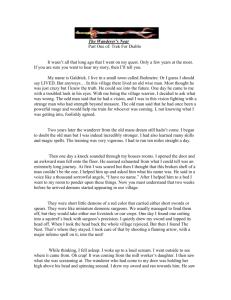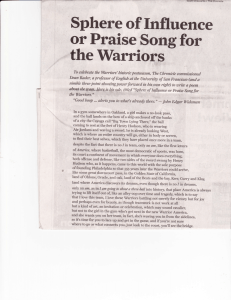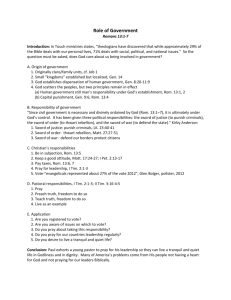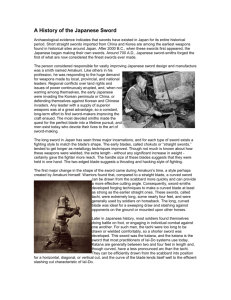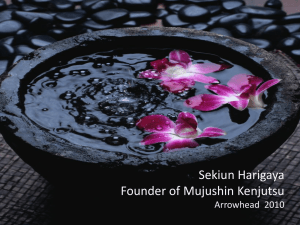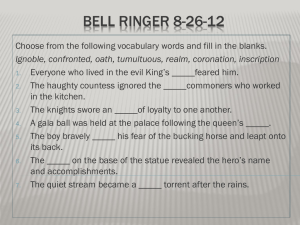Chapter 2 SHODEN OMORI RYU (Seiza) (Beginning Tradition
advertisement
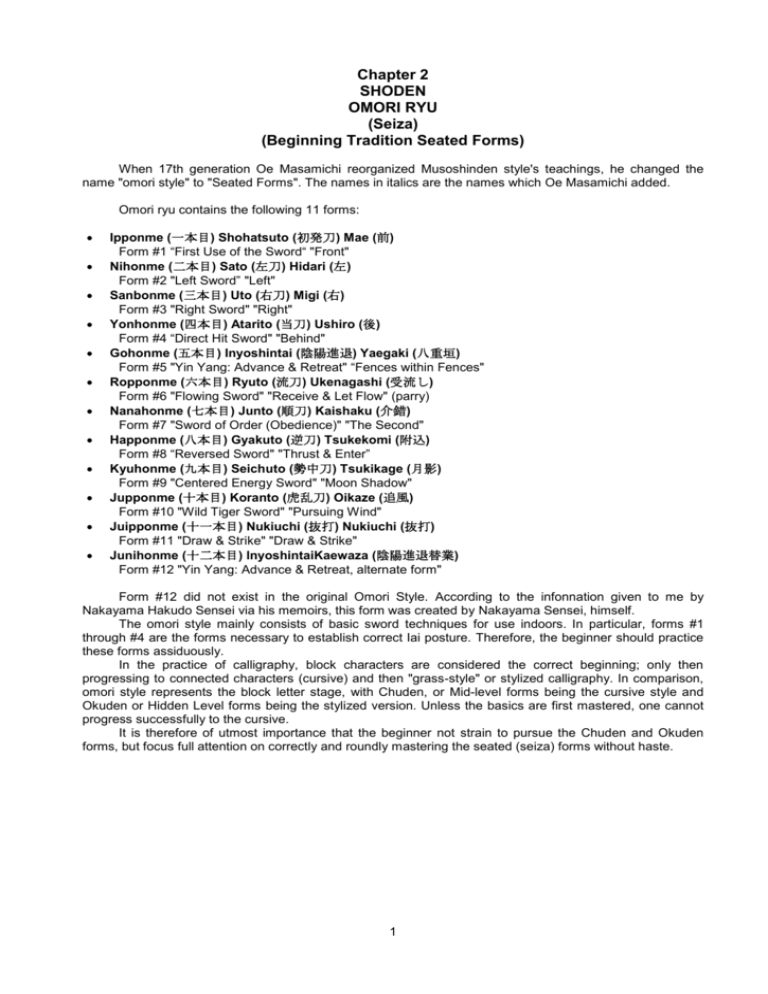
Chapter 2 SHODEN OMORI RYU (Seiza) (Beginning Tradition Seated Forms) When 17th generation Oe Masamichi reorganized Musoshinden style's teachings, he changed the name "omori style" to "Seated Forms". The names in italics are the names which Oe Masamichi added. Omori ryu contains the following 11 forms: Ipponme (一本目) Shohatsuto (初発刀) Mae (前) Form #1 “First Use of the Sword“ "Front" Nihonme (二本目) Sato (左刀) Hidari (左) Form #2 "Left Sword” "Left" Sanbonme (三本目) Uto (右刀) Migi (右) Form #3 "Right Sword" "Right" Yonhonme (四本目) Atarito (当刀) Ushiro (後) Form #4 “Direct Hit Sword" "Behind" Gohonme (五本目) Inyoshintai (陰陽進退) Yaegaki (八重垣) Form #5 "Yin Yang: Advance & Retreat" “Fences within Fences" Ropponme (六本目) Ryuto (流刀) Ukenagashi (受流し) Form #6 "Flowing Sword" "Receive & Let Flow" (parry) Nanahonme (七本目) Junto (順刀) Kaishaku (介錯) Form #7 "Sword of Order (Obedience)" "The Second" Happonme (八本目) Gyakuto (逆刀) Tsukekomi (附込) Form #8 “Reversed Sword" "Thrust & Enter” Kyuhonme (九本目) Seichuto (勢中刀) Tsukikage (月影) Form #9 "Centered Energy Sword" "Moon Shadow" Jupponme (十本目) Koranto (虎乱刀) Oikaze (追風) Form #10 "Wild Tiger Sword" "Pursuing Wind" Juipponme (十一本目) Nukiuchi (抜打) Nukiuchi (抜打) Form #11 "Draw & Strike" "Draw & Strike" Junihonme (十二本目) lnyoshintaiKaewaza (陰陽進退替業) Form #12 "Yin Yang: Advance & Retreat, alternate form" Form #12 did not exist in the original Omori Style. According to the infonnation given to me by Nakayama Hakudo Sensei via his memoirs, this form was created by Nakayama Sensei, himself. The omori style mainly consists of basic sword techniques for use indoors. In particular, forms #1 through #4 are the forms necessary to establish correct Iai posture. Therefore, the beginner should practice these forms assiduously. In the practice of calligraphy, block characters are considered the correct beginning; only then progressing to connected characters (cursive) and then "grass-style" or stylized calligraphy. In comparison, omori style represents the block letter stage, with Chuden, or Mid-level forms being the cursive style and Okuden or Hidden Level forms being the stylized version. Unless the basics are first mastered, one cannot progress successfully to the cursive. It is therefore of utmost importance that the beginner not strain to pursue the Chuden and Okuden forms, but focus full attention on correctly and roundly mastering the seated (seiza) forms without haste. 1 Ipponme Shohatsuto Form #1 “First Use of the Sword“ Intent: You and your enemy are sitting facing each other approximately 1.5 meters apart. Feeling the ill intent of the enemy, you draw your sword, cutting him across his chest or his temple. As he falls, you perform kirioroshi (vertical downward cut), felling him. Execution: 1. Sit in seiza, facing the front (imagine that there is an enemy sitting in seiza, facing you). 2. In order to settle yourself, inhale&exhale 3 times. (This must be completed before you begin the form) 3. Quietly, put both hands on your sword. 4. Rise up out of seiza (leading with your hips) - Kneel with the toes of both feet curled back (flexed) Slowly draw the sword with the blade edge facing up 5. When you have drawn the sword, leaving only about 10 cm in the saya (scabbard), slowly turn the sword sideways, blade outward and parallel to the floor. (1) 6. Stomp the right foot out one step with an audible thud (with the right knee at a right angle to the floor and kneeling on the left knee with legs in a straight line to the front; supported by the left toes which are flexed back). - At the same time, starting with 9 cm of the blade still in the saya, draw your sword with lightning speed and cut horizontally across either the enemy's chest or his temple. (2) - Draw your left toes outwards to the left in order to have your left toes parallel your right leg. - Gripping the koiguchi (koiguchi or carp‘s mouth" refers to the position of having turned the sword horizontally, edge out and drawn). With your left hand, pull the left hand back fully (this is also known as sayabiki or the scabbard draw) 2 o The process of drawing back the left hand is done as follows: with the intent of taking your left elbow (with the koiguchi still in your left hand) and sticking it to you back, draw the saya behind you in a horizontal line (resembling, 一, the Japanese character for one), thereby pulling your left shoulder back. o Upon performing nukitsuke, your right fist should be about level to your right shoulder with the tip of you blade just slightly lower, just enough so that a drop of water would gently trace down the blade to the tip of the sword when dropped at the tsubamoto (base of the guard ring). In the Ogasawara method this is called mizuhashiri (water running). o When the right foot is stomped out, the left thigh should remain perpendicular to the floor. Positioning both legs at right angles makes this a strong position from the front and back and from the left and right. This is the fundamental kneeling posture for Iai. o The left foot (up on flexed toes) should point in the same direction as the right leg (parallel). It is common for the toes to remain on the floor (unflexed) when rising. This is proper only for the seiza (seated) position and should be avoided while kneeling. 7. Take the tip of the drawn sword across to slightly above the left shoulder, about 10 cm away, like you are thrusting it at someone behind you before raising above your head. - Grasp the tsuka (hilt) with the left hand, raising it to jodan (upper) position with both hands. - Slide the left knee up to the right heel. - Before putting your left hand on the tsuka (hilt), bring it to the solar plexus with the left hand still gripping the koiguchi (mouth of the says). This prevents the saya (scabbard) from slipping and also prevents it from getting in the way during kirioroshi (vertical downward cut). (illustration 3) 3 ln this style, furikamuri (raising the sword overhead) always refers to the jodan (overhead) positioning of the sword, whether sitting or standing. 8. Step the right foot out one step. - Slice downward through the center of the enemy (who is directly facing you) (4) o The tip of the blade stops about 15 cm from the floor. o You must not pause with the sword overhead; after bringing it up in furikamuri. execute kirioroshi in one fluid motion. This is called hyoshi no uchi (striking at the opportune moment). 9. After executing kirioroshi: while still maintaining your grip on the tsuka (hilt), slightly twist the hands so that the five fingers of the right fist ate turned upward. (5) 10. Release the left hand from the tsuka (hilt) and place it on top of the saya at the hip. (The left thumb should push down on the saya so that the tip does not strike the floor. - Extending the right elbow, open the sword to the right side, horizontally. (6) The right fist should be at the level of the right shoulder, with the kensen (sword tip) opening outward to the right as if thrusting it diagonally behind. 4 11. Bend the right elbow toward the head, bringing the right fist close to the right temple (7) (The left hand remains at the hip). 12. As you rise up, the right elbow extends at a 45 degree angle from the body, Stretch the right elbow in front of the body (as you are swinging the blade around with the extension, the tips of the middle finger and thumb should brush the hair on the right side of your head-this is the correct distance). 13. The kensen (sword tip) should be brought horizontally to the right in a slanting position for chiburi (blood clearing). (8) (9) 5 This is called Omori styled chiburi. Unless otherwise specified, this is the chiburi method to be used in all forms. For chiburi, the kensen (sword tip) should end facing approximately parallel to the right foot, which is in front. When performing the downward movement of chiburi, excessive force should not be used; this should be executed naturally, as if shaking raindrops from an umbrella. However, the grip of the little finger and the ring finger should be tightened on the tsuka (hilt) at the instant of completion. 14. Maintaining chugoshi (centered hips), slide the left foot up even with the right foot (Maintain a position with both knees slightly bent forward and the hips dropped slightly. This is called Iaigoshi (lai hips).) 15. Draw the right foot back (the left and right feet exchange places). (10) 16. After solidly setting the position of the hips, take the left hand quietly from the hip and grip the koiguchi (mouth of the scabbard). 17. Place the spine of the sword blade close to the tsuba (guard ring) in the hollow created by the thumb and crooked index finger. (11) 6 18. Extend the right elbow until the blade tip comes to the koiguchi, extending the right hand in front of the left hand. (12) - Using the left hand to pull back on the saya (scabbard) so it forms the shape of the Japanese character "one" (一), insert the kensen (sword tip) into the koiguchi. 19. As you begin to slide the blade into the saya (scabbard), slide the saya slightly forward as if to meet the sword. - When performing both batto (drawing) and noto (re-sheathing), the blade of the sword should be inserted or drawn out as if rubbing the spine of the blade on the saya. 20. Insert the First 2/3 of the blade with both the sword and saya held in a horizontal position. Upon reaching the last 1/3. 21. Slowly begin to turn the sword and saya blade up. - The right knee should touch the floor just as the re-sheathing is completed. (The position is the same as the basic kneeling position.) (13) 7 o When the sword length is long compared to the body, turn the hips slightly to the left to re-sheaths the sword. o When performing noto, it is highly important to keep the upper body straight, putting strength into the lower abdomen and maintaining full zanshin (zanshin means to maintain full intent and focus before, during and after one's action). o The chiburi movement should be executed in one slow, smooth motion. Nihonme Sato Form #2 “Left Sword” Intent: To your left. about 1.5 meters away, there is an enemy facing in the same direction you are. You turn to face the enemy with a nukitsuke (horizontal draw and cut), then execute kirioroshi (vertical downward cut). This form is equivalent in intent to form #1 Shohatsuto. Execution: 1. Putting the front to your left (you turn right, with your left shoulder facing the front), assume seiza (sitting posture). 2. As you are performing nukitsuke (draw cut)… 3. Using the right knee as a pivot point, turn 90 degrees to the left, to face the enemy sitting next to you. Draw the first 2/3 of the sword. (1) 8 4. As you finish turning, stomp the left foot one step forward. Draw the sword at the opponent's temple. (2) 5. Execute furikamuri, bringing the sword up to jodan position and execute kirioroshi (downward cut). 6. Execute chiburi (blood clearing; Omori style). 7. Slide the right foot forward, even with the left foot. 8. Draw the left foot back and with the right foot forward, end in kneeling position (the same as in form #1). There is no need to rush the turn to the left. With the intent of dominating the enemy, turn slowly, synchronizing the speed of the turn with the speed of the draw. When you have turned to face the front, take the kensen (sword tip) with only about 9 cm remaining in the saya (scabbard), and suddenly draw the sword and execute the horizontal cut as done in Shohatsuto (form #1). 9 Sanbonme Uto Form #3 "Right Sword" Intent: About 1.5 meters to your right, an enemy sits facing the same direction you are. From seiza (sitting position), you turn and face the sitting enemy with a nukitsuke (draw and cut), finishing with kirioroshi (vertical downward cut). This form is equivalent in intent to form #1, Shohatsuto. Execution: 1. Put the front to your right (you turn to your left) and sit in seiza. 2. As you are performing nukitsuke (draw cut). 3. Using your left knee as a pivot, turn 90 degrees to your right, facing the enemy who sits at your right. Draw the sword 2/3 of the way out. (1) 4. As soon as you complete the turn, stomp the right foot forward with an audible thud. - Execute nukitsuke (draw and cut) to the enemy’s temple. (2) 5. Execute furikamuri (bringing the sword up overhead) and finish with kirioroshi (vertical downward cut). 6. Execute chiburi (blood clearing; omori style). 7. Slide the left foot forward, lining it up with the right foot. 8. Draw the right foot back. As you perform noto (re-sheathing the sword), end in kneeling position with the left knee up. The only difference from Sato (form #2) is the order of the feet. 10 Yonhonme Atarito Form #4 “Direct Hit Sword” Intent: An enemy is sitting directly behind you about 1.5 meters away, facing your back. You wheel around in one motion and at the same time you face the enemy, you perform nukitsuke (draw and cut), finishing with kirioroshi (vertical downward cut). This form is equivalent in intent to form #1 Shohatsuto. Execution: I. From the front, you turn to the right and assume seiza (sitting position) to the back (your back will face the front). (1) 2. As you begin to draw your sword, turn to the left 180 degrees, using your right knee as a pivot point. 3. Facing the enemy, step your left foot out one step with a resounding thud. - Perform nukitsuke (draw and cut) to the enemy's temple. (2) 4. From jodan (upper position), execute kirioroshi (vertical downward cut). 5. Execute chiburi (blood clearing; Omori style). 6. Switch feet; then slowly drop to kneeling position. o It is common for the right leg not to turn all the way when turning to the left. This is incorrect. You must rotate the right leg until the shin is in alignment with the left leg. 11 o When standing up from the kneeling position, stand up and align the back foot (the one with the knee on the ground) with the standing front foot. Drop the right hand away from the tsuka (hilt) and drop it to the side of the right thigh. This ending motion is the same for all three forms thus far and holds true for all of the following forms. Gohonme Inyoshintai Form #5 "Dual force of Advance & Retreat" Intent: Sitting in seiza directly facing the enemy who is sitting in front of you, draw and cut with nukitsuke with the same intent as in Shohatsuto. However, the result is insufficient. The enemy tries to retreat, so… As you stand, step the left foot out one step and execute kirioroshi (vertical downward cut) on the enemy and begin noto (re-sheathing). Then… One more enemy advances at you ready to cut so you step back one full step, giving yourself ample room and draw with a horizontal cut across the enemy's hips. Then you execute furikamuri (bring the sword overhead) and finish with kirioroshi (vertical downward cut). This form involves felling two enemies in succession. Execution: 1. Sit facing the front in seiza. 2. With the same intent as in Shohatsuto, draw and execute nukitsuke (draw and cut). (1) 3. Since the first attack was insufficient, the enemy attempts to retreat backward. Just then… 4. Without leaving any interval (opportunity to escape), raise the sword above your head in furikamuri as you stand up. 5. Step the left foot forward one step. - Maintaining chugoshi (centered hip position), cut down the center of the enemy from jodan (upper position). (2) 12 Upon completion of kirioroshi (vertical downward cut) the kensen (sword tip) should be slightly lower than level. At this point, you have felled the first enemy. 6. Drop the right knee to the floor. - Take the left hand off the tsuka (hilt) and place it on the left hip. With the sword still in the right hand, execute a horizontal chiburi (blood clearing) with the blade facing outward to the right. (3) When executing chiburi, the sword is angled slightly to the right and down, with the kensen (sword tip) pointing straight to the front and dropped enough for a drop of water to run down the blade. This chiburi style is called Eishin ryu Chiburi or Suihei noto (horizontal or level) chiburi. 7. Just before completing noto (re-sheathing), draw your left foot back so that the heel touches your buttocks. (4) 8. Now the second enemy advances with an attack, so you draw the left foot fully back. - Standing in chugoshi (centered hip position) stance, perform nukitsuke (draw and cut). (5) 13 9. As you perform furikamuri (raising the sword overhead), drop the knee to the floor. 10. Slide the left knee up to the right heel. - As you step the right foot out with an audible thud, simultaneously execute kirioroshi (vertical downward cut) as in Shohatsuto. 11. Execute an omori style chiburi (blood clearing). 12. Perform noto (re-sheathing). 13. Stand up. Ropponme Ryuto Form #6 “Flowing Sword” Intent: An enemy sitting about 1.5 meters out to your left is facing in the same direction. He stands up and starts to strike down at you. (Or you may imagine an enemy that comes running in from your left with an attack.) You parry the enemy's sword with your own. As the enemy begins to stumble forward, you turn slightly to the left of the front and cut through the enemy's saya (scabbard) and left hip. Execution: 1. Assume seiza (sitting) position with the front to your left. 2. You either feel the enemy's intentions or look to the left and see him. (1) 14 3. The enemy strikes at your head with kirioroshi (vertical downward cut). In response… 4. Step your left foot out slightly to the right (one foot width) with an audible thud. - The right hand grips the hilt from the upper outside (palm down, facing inward) and quickly draws. - Turn your upper body to the enemy. - Extend your right elbow up, thrusting the sword above and in front of the left shoulder (with the kensen (sword tip) pointing slightly lower than level) - Fully using your left hand to draw back. - With a clashing sound, block the enemy's sword with your own at a point about 20 cm from the tsuba (guard ring) and with the shinogi (ridge line on the side of the sword). (2) When parrying the enemy's sword. it is important not to lock your elbow; rather, keep it slightly loose. 5. Stepping your right foot out to the right side (at a 45 degree angle), stand, assuming chugoshi stance with an audible thud. - Parry the enemy's sword with ukenagashi (receive and let slide). (3) 15 In order to release the enemy's blocked sword, drop your right elbow to your right armpit and your right fist in front of your right shoulder, thereby dropping your own sword behind your neck. Shoulder it horizontally. 6. Turn your left toes slightly to the left of the enemy (who is directly in front of you and is leaning or falling forward). - Aligning the right heel with the left heel, step forward with an audible thud. - Bring the sword down and add the left hand; with both hands execute a cut through the enemy's saya (scabbard) and hips. (4) At the moment of contact, bend your knees 80 degrees to the left and drop your hips down (The feet are held in an open fan pattern). Extending both elbows fully; squeeze with the palms and drop the hands lower. The blade should be angled diagonally downward to the left (at a 45 degree angle); so that you cut through the opponent's hips. In the split second before the blade hits the target, add the left hand and using the palms, cut through. The rhythm of the left and right footsteps is not equally spaced out like O-O-O; the first is separated from the second two like O-OO. Move smoothly, synchronizing the feet, the body and the hands in one fluid movement. 7. Having made the cut, turn the toes of both feet slightly to the right and turn your body to face straight ahead. 8. Sliding the left foot far back, straighten the upper body. - Draw the sword down with the hands until the tip is about 15 cm from the floor. (5) 16 9. Turning the four fingers of the left hand down and the palm of the right fist up and keeping the tip of the sword as if it were floating above the right knee, turn the sword around. At this time, gently extend both elbows out to the left front at the level of the shoulders. 10. With the back of the right hand facing up, exchange your grip on the tsuka (hilt). (6) (7) 11. Take the left hand from the tsuka (hilt) and grip the koiguchi (scabbard mouth). 12. With the sword held in the reversed right hand with your palm up, point the sword towards the left elbow and turn it around. 13. At 2/3 of the blade length from the tsuba (guard ring), place the spine of the sword against the koiguchi (scabbard mouth); keeping the right hand reversed, draw the right hand out to the right so that the sword forms a horizontal line (like the Japanese character for ‘one’, 一). As you perform noto (re-sheathing), drop the left knee to the floor. (8) (9) 17 Regarding noto (re-sheathing): After completing noto with the hand in the reversed position, continue to grip the tsuka (hilt) with the right hand and quietly turn it to the left so that when note is finished, the thumb and index finger from a triangular hollow, facing straight up. When you have finished noto, slide the right fist up toward the base of the tsuba (guard ring). Make sure that you complete the rotation from side to straight up by the completion of note. During this whole process care must be taken to keep the grip tight on the tsuka (hilt), ready to draw and thrust at the enemy. There are people who perform noto with the blade up and with a snapping motion; however, this is the method of the yakuza (Japanese mafia) and we do not do this in our style. (A) (B) (C) Nanahonme Junto Form #7 "Sword of Order (Obedience)" Intent: This is the act of beheading a samurai who is committing seppuku (ritual suicide). Standing to the left and two steps behind the person committing seppuku (about 50-60 cm behind), sit in seiza facing the person. Wait for the proper time to assist in the ritual suicide. Since there is no enemy to react to, execute this form quietly from beginning to end. This form is never performed at public functions such as conferences, tournaments or celebratory occasions. Execution: 1. Face the front and assume seiza (sitting) position. (1) 18 2. Keep your eyes to the front on the seppukusha (person committing suicide). - Using the left knee as a pivot, quietly turn 90 degrees to the right and - Step the right foot quietly out one step - Draw 1/3 of the blade out facing the right knee leaving it blade up. (2) 3. Keeping your eyes of the seppukusha, stand up. - Unsheathe the sword with the tsuka (hilt) and saya (scabbard) facing upward. (3) - At the precise moment the kissaki (blade tip) has cleared the saya (and while fully standing up) - Turn the left foot to face the front - Step the right foot forward to the left foot to face the seppukusha directly - Draw the right foot to the left foot and align them. (4) 19 o At this time, raise the sword above the shoulder and hold it in readiness. The right hand is held in front of the right shoulder at the height of your breast. o Do not hold the sword like a shoulder carrying pole. 4. Synchronize your breathing with that of the seppukusha. - Stepping the right foot forward one step - Use both hands to raise the sword to jodan (upper position) (5) - As the right foot steps forward and touches the floor - Extend both elbows and using the palms, cut through the seppukusha’s neck bones, taking care to leave the skin at the front of the throat intact (so that the head won't drop off unceremoniously). 5. Then gently cut the skin of the throat so that the head fall off. (6) 20 6. Maintaining this position, lower the kensen (sword tip) and execute the same noto as in the form Ryuto. (7) o While a beginner, it is usual to step the right foot forward and make sure that the body position is completely correct before executing the cut. However, try to practice making contact with the seppukusha’s neck as the right foot touches the floor. o After the sword has been raised to jodan (upper position) by the shoulder it is not lowered. Kirioroshi (vertical downward cut) is performed from this position. o When the sword makes contact with the neck the blade should not be level. Since the seppukusha will be leaning forward to reach for the short sword on the offering table, the blade should be held at an angle of 30-40 degrees. 21 Happonme Gyakuto Form #8 “Reversed Sword” Intent: The enemy approaches from the front, attacking with kirioroshi (vertical downward cut). In response, you take one step back while blocking the opponent's sword so that it slides off to the left. Return with your sword for a face cut. When following the enemy who is attempting to flee backward, you pursue him and perform a complete kirioroshi (vertical downward cut). Execution: 1. Face the front and assume seiza (sitting) position. 2. In response to the enemy's advance, step the right foot out l/2 foot length from the left knee. - Come up on the left toes, rising from the hips. Draw the sword 15-20 cm and watch the enemy. The right fist should be on the outside of the right kneecap. (1) 3. The enemy attacks with kirioroshi (vertical downward cut) from the front, so step the right foot back to the left foot as you stand up - Draw the sword blade upward. (The kensen (sword tip) should clear the saya at the same time the right foot reaches the left foot). - As if to protect your head and left shoulder, use your sword to block the enemy's sword and deflect it to the left. (2) o When deflecting the enemy's sword, hold the right list about 15 cm away from the head and to the right with the right elbow held in a relaxed upward position, stretched out. o When the enemy enters deeply with his cut it is ok to also move the left foot slightly back as well. You may also move the right foot back to match the left foot position. In other words, maintain a proper distance for parrying the sword. 22 4. After deflecting the other sword, turn it around. - From jodan (upper position) cut the enemy from the top of the head to the jaw. (3) In order to perform the first cut, do not raise your left hand above your head; rather, in the moment you execute kirioroshi (vertical downward cut), join the left hand to the tsuka (hilt). In order to avoid the unwounded enemy running away, you must perform the cut quickly, immediately after blocking. 5. The enemy falls backward due to the wound he has sustained, but the wound from the first cut is a shallow one and he tries to run away. So take a large step forward with the left foot. - At the same time. raise the sword overhead (from the left shoulder) - Slop the right foot forward with a large step (left. right foot pursuit). - As you step with the right foot cut the enemy from the face to his navel. (4) 23 6. Step the left foot up to the right foot; immediately sliding the right foot backward in large step (stance change). - Grip the sword with both hands in jodan (upper position). (5) Maintain zanshin (guarded watchfulness) while bringing the sword up overhead. 7. Quietly drop the right knee to the floor. - Slowly draw the sword down as if to hold down the enemy. (6) 24 8. Take the right hand off the tsuka (hilt) and reverse the holding position. (7) In other styles the sword is lowered above the enemy and you remain kneeling in a wait-and-see posture. The sword is reversed with the right hand and the left hand guides the spine as the sword is drawn upward. This is called chinugui (blood wiping). - Set the first knuckle depression of the index finger on the spine of the sword near the monouchi (striking section). Raise the right fist until it is even with the right shoulder, drawing the sword upward (it is ok to draw it up in one fast motion). (8) 9. Remaining in kneeling position with the sword still reversed in the right hand, turn the blade outward (and level or parallel to the floor). - Hold the sword horizontally in front of your novel. 10. Grip the koiguchi (scabbard mouth) with the left hand. Pulling the sword straight out, place the spine of the sword 2/3 of the length from the tsuba (guard ring) at the koiguchi. (9) 11. Pulling your right fist to the right, execute noto (re-sheathing). 12. Slide the left heel back to the right knee (assuming a crouching posture). 13. Stop the left foot out and stand up. 25 Kyuhonme Seichuto Form #9 "Centered Energy Sword" Intent: An enemy comes from your right with sword upraised in jodan position, ready to strike. You draw your sword and cut through both forearms. As he begins to retreat, you step forward and fell him with kirioroshi (vertical downward cut) from directly in front. The reason Oe Sensei named this formwith the elegant name of [Tsukikage] “Moon Shadow" was probably because the silhouette of the sword cutting the forearm from underneath resembles the shape of the waning moon. Execution: 1. Turn to your left, putting the front to your right and sit in seiza. (1) 2. The enemy launches a strike from jodan (upper position), so turn 90 degrees to the right, using your left knee as a pivot point. - Stand up in chugoshi (centered hip) stance, stepping the right foot straight ahead at the same time you execute nukitsuke (draw and cut). (2) - From chugoshi stance, draw your sword angled upward toward the right to cut the enemy's right forearm (maintain the intent of cutting through to the left arm as well). (3) 26 3. As the enemy begins to retreat, step your left foot forward, aligning it with your right foot. - Perform furikamuri; (raising the sword overhead) from your left shoulder & parry the opponent's sword in the process. - Join the left hand to the tsuka (hilt) for a two-handed jodan (upper position). 4. Again, step the right foot forward. - Execute kirioroshi (vertical downward cut) from directly in front of the enemy.(4) (The timing of the right foot touching the ground and the sword making contact with the enemy must synchronize). The speed from the cutting of the enemy's arms to kirioroshi (vertical downward cut) must be rapid. 5. Remaining in the standing position after kirioroshi is completed, execute an omori style chiburi (blood clearing). 6. Exchange the right and left feet. 7. Just as in Shohatsuto, return to kneeling position as you complete noto (re-sheathing). 8. Rise off the right knee, bring the right foot to the left foot and stand up. When turning right to face the enemy and cutting through his arms, it is important for the back left toes to line up completely with the right leg (not assuming the shape of shumoku ashi (wooden bell hammer; meaning angular or T-shaped legs). Maintain chugoshi (centered hip) stance when you perform. 27 Jupponme Koranto Form #10 "Wild Tiger Sword" Intent: You are overtaking and cutting down an enemy in front who is edging backward in an attempt to flee. The entire form is executed in a standing position. This is the only Shoden (beginning tradition) form that is performed in a standing position. Execution: 1. Stand straight facing the front. 2. Slide the left foot one half step in front. - Put both hands on the tsuka (hilt) (1) The purpose of stepping the left foot out in front is to make it easy to execute a powerful nukitsuke (draw and cut). You should twist your hips slightly to the right, with the tips of the left toes pointing slightly to the right. When you step the right foot forward, your hips should twist slightly to the left as you perform nukitsuke (draw and cut). The name of the form comes from the fact that a cat (or a tiger) steps in this manner when stalking its prey. 3. Step the right foot out with a large step. - As in Shohatsuto, draw and cut the enemy's face. (According to the circumstances, it is also appropriate to cut the neck or the chest.) (2) 28 4. As you step the left foot forward - Execute furikamuri (raising the sword overhead) from the left shoulder as a defensive parry. 5. Again, take a large step forward with the right foot. - Perform kirioroshi (vertical downward cut) through the enemy. 6. Maintaining standing position once kirioroshi is completed, execute an omori style chiburi (blood clearing). 7. Step the left foot forward, aligning it with the right foot. 8. Slide the right foot back a 1/2 step to execute noto (re-sheathing) in a standing position. (3) Do not sit down even after sheathing your sword. As the name, Oikaze (‘Pursuing Wind") illustrates, this form should be performed as if you were the wind chasing the enemy: smoothly and quickly. It is also possible to imagine that the first cut is not effective and the enemy continues to inch backwards. You pursue him with the drawn sword thrusting directly at him - one step, two steps and then fell him with a direct kirioroshi (vertical downward cut). 29 Juipponme Nukiuchi Form #11 "Draw & Strike" Intent: You and the enemy are sitting in seiza, facing each other in close proximity. Feeling the ill intent of the enemy, you quickly draw your sword and execute kirioroshi (vertical downward cut) directly through the enemy. Execution: 1. Face the front in seiza (sitting position). 2. Grip the tsuka (hilt) with the right hand; open the koiguchi (scabbard mouth) with the left hand. - Raise up from the hips, coming up on both sets of toes (toes flexed) Simultaneously draw the sword rapidly with the blade up to the right diagonal. (1) (2) 3. When the kensen (sword tip) has just barely cleared the koiguchi - Execute furikamuri (raising the sword overhead) as if to thrust the tip of the sword back to the upper outside of the left elbow and raise it overhead (joining the left hand to the right), assuming a twohanded jodan (upper position). - Draw both knees all the way together. 30 o Make sure that you draw your upper body up tall, directly over your knees. (3) o The draw to furikamuri is executed in one continuous motion and must be done quickly. 4. From jodan (upper position), execute kirioroshi (vertical downward cut) directly through the center of the enemy. - Both knees slide open in a quickly snapping motion (as if to make a thumping noise on the floor). (4) Upon completion of kirioroshi (vertical downward cut), both heels remain all the way together. 5. In this position, perform the Eishin style chiburi (straight blood clearing). (5) 6. As you perform noto (re-sheathing) - Quietly lower your buttocks to rest on top of your heels, making contact at the moment that you seat the sword. 7. Quietly move both knees together. 8. Stop the right foot forward one step. As you draw the left foot to the right foot, stand up. This completes the form. 31 Junihonme lnyoshintaiKaewaza Form #12 "Dual forces of Advance & Retreat" Intent: This form carries the same intent as form #5 lnyoshintai; however. In this form, a second enemy steps forward to attack your right leg, so you parry his cut with your sword to protect your shin. Then execute kirioroshi (vertical downward cut) through the center of the enemy. Execution: 1. Sit in seiza, facing the front. 2. The response to the first enemy is exactly as it is in form #5. However, when performing noto (resheathing), before the habaki (sword collar) touches the mouth of the saya (scabbard). 3. The second enemy steps forward to cut your right leg, on you grab the tsuka (hilt) with an overhand grip in your right hand - And standing up - Step the left foot back one large step - When the kensen (sword tip) clears the koiguchi (scabbard mouth), fully move your drawing hand (left) backward. With the kensen (sword tip) down, move the sword around to block to the outside of your right leg. Block with the shinogi (ridge line), thereby knocking the enemy's sword away and protecting your shin. (1) (2) 32 4. Quickly slide your left knee up to the right heel (in kneeling position). - Execute furikamuri (raising the sword overhead). Execute kirioroshi (vertical downward cut) directly through the center of the enemy. 5. Perform the same chiburi (blood clearing) as in Shohatsuto and perform noto (re-sheathing). o When blocking, your sword tip should be parallel to (in line with) your right foot. (3) o Rather than simply think of protecting your leg from the enemy's sword, the block is strong, with the intent of knocking the enemy's sword down and away. 33
